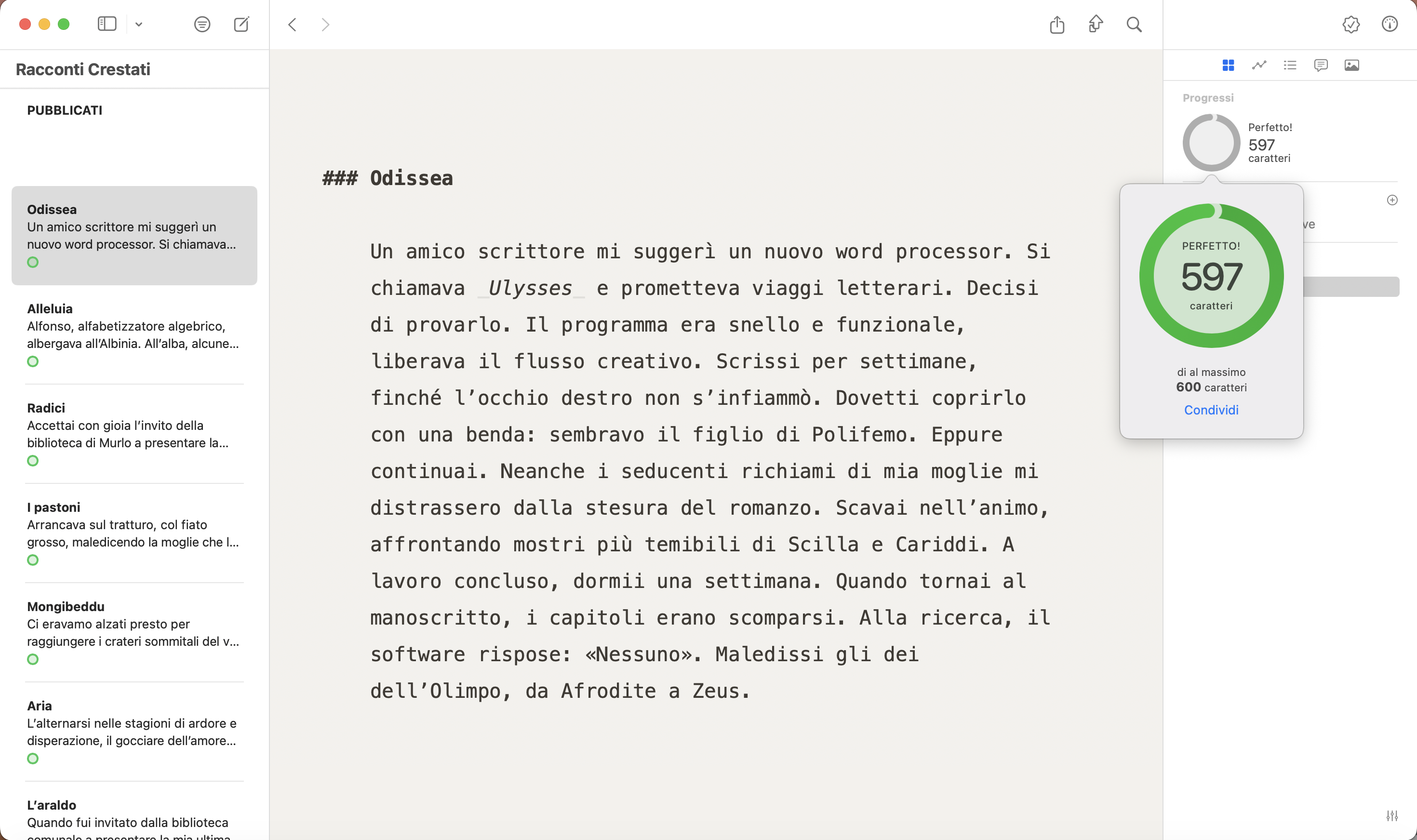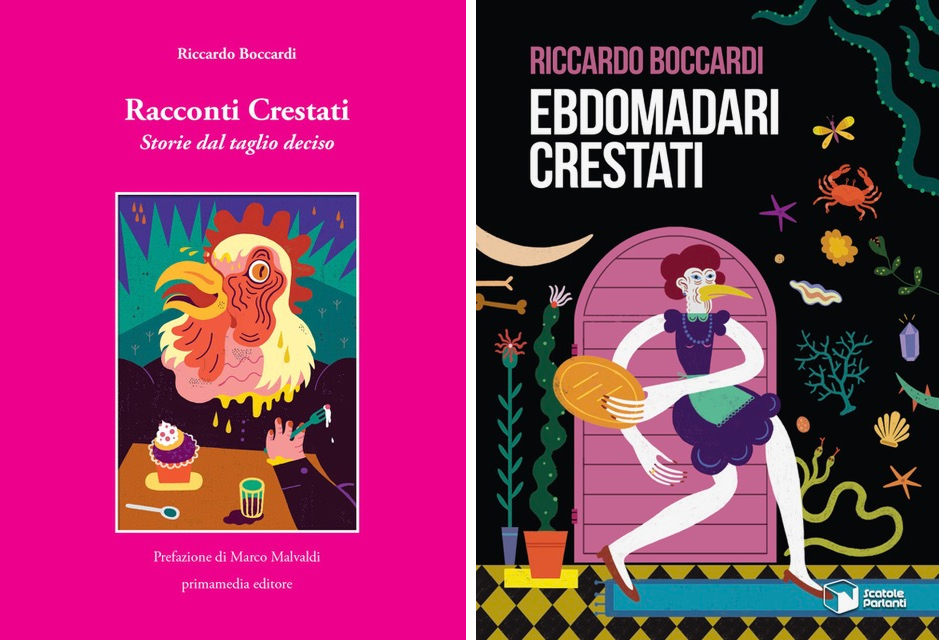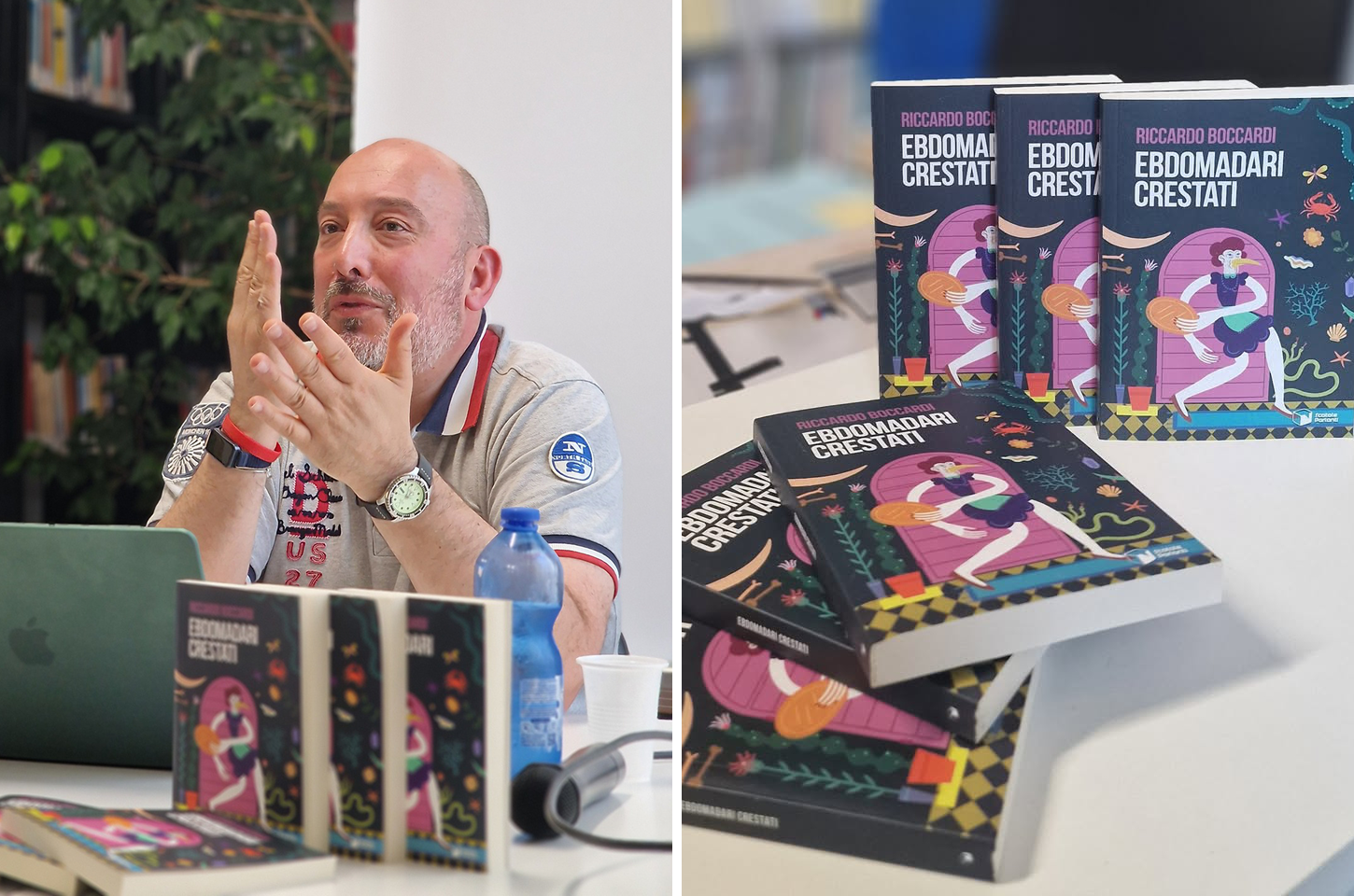Riccardo Boccardi is a writer from Montalcino, Italy, known for creating Racconti Crestati, a vast collection of micro-stories each just under 600 characters long. Aside from being an impressive achievement in its own right, Riccardo’s stories have also inspired more than a thousand illustrations and several musical jingles by other artists. A selection of stories has turned into two published books as well as university teaching materials.
Can you tell us a bit more about Racconti Crestati and what inspired you to create this interesting project?
It all started in 2017 with the creation of a simple Facebook page. The idea was to share short stories, as long as a single post, meant to be read perhaps on the subway or while waiting for a bus. They had to suit a new form of communication: fast, immediate, and capable of capturing attention in just a few seconds. I named the project “Racconti Crestati” (Crested Stories) and chose a Mohawk hairstyle as its logo. The hairstyle symbolized the principle behind these stories: they needed to be direct, sharp, and full of character. Just like that haircut, all the superfluous was stripped away, leaving only what was essential. At first, I wrote a story every day, but the pace soon became unsustainable, so I switched to one “crested” story per week. Since then, these texts have been my companions: through them, I capture thoughts, visions, and fantasies, giving life to tales that are often grotesque or surreal.
As a writer, what draws you to the short story, or more like, micro-story form?
At its core, it’s about explosiveness. Everything unfolds in just a few breaths, even though each story can continue to echo in the reader’s mind long afterward. In my writing, I always try to suggest a “before” and an “after” surrounding the events I narrate: this way, time stretches, and the characters take on a fuller life in the reader’s imagination. Thanks to their brevity, micro-stories allow me to explore a wide variety of themes and literary genres, from the grotesque to noir, from romance to science fiction. Sometimes a single line of dialogue is enough to spark an entire story. Other times, the tales emerge from playful linguistic experiments, such as tautograms or lipograms.
It seems clear from your project that you enjoy working with constraints—what motivated you to set the limit of just under 600 characters for each story? How do these limitations foster creativity in your writing?
At first, when I was drafting my texts, I hadn’t set a precise length—let alone the strict one I follow today. Over the weeks, however, two guiding numbers emerged: 597 and 598. In fact, each of my stories must meet one of these character counts (excluding spaces, title included). Within this exact framework, my imagination moves freely, and my creativity is honed. In such a small space, every sentence, every word, every punctuation mark must be carefully chosen to create the right rhythm and evoke the intended atmosphere. What might seem like a limitation is, in fact, my greatest freedom: it allows me to cross boundaries I otherwise could not.

What is your creative process for crafting each of these concise stories? How does your writing routine look, and how has it contributed to your creative output?
Stories can emerge from a variety of sources: an everyday event pushed to the extreme, a person you meet who becomes a character, the musicality of a single word that becomes the story’s pivot, or a dormant memory that resurfaces and transforms. I don’t follow a strict routine: I set my goal in Ulysses (a maximum of 600 characters, excluding spaces) and then develop the story. Usually, I already know the ending and write the story backward. Other times, I begin with a theme or a striking image. Some “crested” stories are born quickly, while others require weeks of gestation before they come to life.
You have been using Ulysses since its very first release, which was in 2003, and have written over 570 micro-stories with it. What makes Ulysses such a perfect writing companion for you?
The first time I used Ulysses, I didn’t fully grasp its structure or potential. It was revolutionary: minimal, essential, almost stark in its simplicity. Everything existed in a shared, undefined space—no separate files, no folders, no formatting tools. Only through regular use did I come to appreciate the hidden power beneath its simplicity, and the advantages it offered both in the creative process and in managing texts structurally. Since then, it has become my daily writing companion. The ability to organize hundreds of texts with clarity and security is unmatched. The only thing I miss is the icon from the earliest versions: that “U”, part bard’s lyre, part Minotaur’s horns.
Writing over 570 micro-stories surely changes how you perceive narrative over time. How has this influenced your understanding of storytelling or your approach to new creative ideas?
Essentially, it has allowed me to sharpen my imagination, explore a wide variety of themes, and blend the comic with the dramatic, and vice versa. The natural science knowledge I gained at university has found new life in this literary form, which preserves the rigor and organizational skills of science. Metamorphoses, symbioses, geological events, and peculiar creatures often take center stage in my stories. Condensing, optimizing, and synthesizing are integral to the way I think, which is why the ultra-short form of writing suits me so well. Yet it remains a valuable exercise: when practiced consistently, it helps uncover new narrative and linguistic solutions, making each text more impactful in its brevity.

Even though all micro romanzi (micro-stories) are written by you, there is a strong encouragement of collaboration in this project. What is it like working together with illustrators, performers, and musicians? Do you feel that such interpretations elevate your stories, and, in turn, is your writing also influenced by other art forms, such as music, film, or visual arts?
Yes, the project has had a collaborative and voluntary spirit from the very beginning. It started with readings by Italian crime writers, then moved to illustrations—now numbering around 1,300—followed by performances from actors and voice-over artists, and finally musical jingles. Many of these collaborations are international, stretching from China to Chile, from Spain to Russia. The magic of it all lies in the fact that each creation springs from just a handful of words—a few sentences capable of connecting continents. Without a doubt, art feeds art, and I am constantly amazed at how illustrators interpret the stories in ways I had never imagined. As for influences on my writing, I believe every experience adds a new layer to the creative process: cinema, music, TV series, books, comics, or even simply lounging on the sofa.
It is clear that Racconti Crestati spread widely in the art world, crossing into many fields beyond writing. Was that your plan from the start, or did it grow in that direction over time? And what impact do you wish to create with this project?
The original idea was simply to bring new “interesting” content to a social network that, even then, was filled with images and trivialities. Collaborations began shortly after, sparked by simple requests sent through Facebook. As you can see, generosity is far from dead…
As for the future of Crested Stories, I don’t have any specific plans at the moment, apart from continuing to write and nurturing artistic collaborations.
This is a digital-first project, with all stories freely available on the project’s website (www.racconticrestati.com), but it has also grown to include printed editions with two published books. Can you tell us how Racconti Crestati evolved from digital shorts to printed books? And how has reader feedback, especially from online platforms, influenced the direction of the project?
Two collections of micro-stories have been published: one in 2019 (“Racconti Crestati”, Primamedia Editore) and one this year (“Ebdomadari Crestati”, Scatole Parlanti). The first contains 196 stories, the second 200. Both include a previously unpublished story that never appeared online. Transitioning from the web to print required careful selection and refinement of the texts: when something is printed, it demands the utmost attention and precision. “Scripta manent”, as my Latin ancestors used to say. Although short stories are not widely appreciated by the general public in Italy, both publishers embraced these brief tales enthusiastically—perhaps because of their unusual conciseness and themes. Reader feedback hasn’t shaped the project, but today, fans of the “crested” stories can enjoy them online and also have a physical copy on their bedside table.

One of the books was also used as teaching material in a storytelling course at the University of Turin. How did this come about? Could you share your thoughts on what micro-stories can teach us about storytelling? What insights have you gathered during this project that you’d like to share with aspiring short story writers?
From the very beginning, my stories received the appreciation of Alessandro Perissinotto, an Italian crime writer and storytelling professor at the University of Turin. When my first printed collection was released, Alessandro—who later wrote the preface for the second anthology—selected Crested Stories as recommended reading for his course. It was a tremendous honor, and I still take this opportunity to thank him.
I believe micro-stories offer the chance to experiment with a variety of narrative techniques: ellipses, plot twists, reversals, temporal contractions or expansions (as perceived by the reader), and the evocative power of words. My advice for anyone venturing into short-form writing is simple: write. Often, people are drawn only to the idea of being a writer, without realizing how demanding, solitary, and sometimes frustrating it can be to turn one’s imagination into words. The message is clear: write even when you don’t feel like it. With a bit of luck, inspiration will follow.
Lastly, after many years of writing micro-stories, how do you see the future of Racconti Crestati? Are there new formats, collaborations, or directions you’d like to explore next?
I believe this project will continue to accompany me for several more years: by now, these short stories have become an integral part of the way I view the world, its people, and its events. Often, when observing a face, a gesture, or a situation, I can already see one of my quirky stories taking shape. Looking ahead, I remain open to all kinds of artistic collaborations, without restrictions of genre or form. I have also experimented with longer stories, earning positive reviews and recognition in national competitions. My current goal is still the publication of a novel… but if that doesn’t come to pass, I can always weave together a thousand micro-stories.
If you’d like to read more from Riccardo, make sure to check out his personal website or his project's website and Facebook page.
